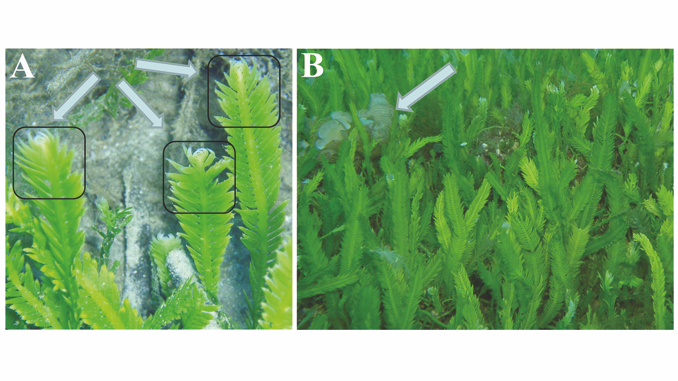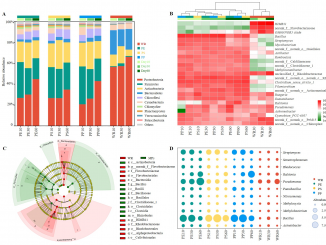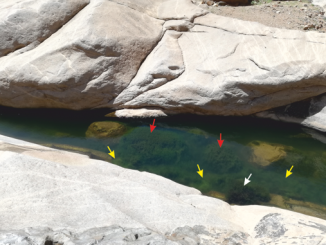
Paper category: Original research paper
Corresponding author: Ana Car (ana.car@unidu.hr)
DOI: 10.2478/ohs-2019-00019
Received: 14/11/2018
Accepted: 28/01/2019
Full text: here
Citation (APA style): Car, A., Witkowski, A., Dobosz, S., et al. (2019). Epiphytic diatom assemblages on invasive Caulerpa taxifolia and autochthonous Halimeda tuna and Padina sp. seaweeds in the Adriatic Sea – summer/autumn aspect. Oceanological and Hydrobiological Studies, 48(3), pp. 209-226. Retrieved 3 Oct. 2019, from doi:10.2478/ohs-2019-0019
Abstract
This study focuses on the taxonomy of epiphytic diatoms in the area of invasive macroalgae from the genus Caulerpa. Caulerpa species are characterized by the presence of secondary metabolites, such as caulerpenyne (CYN), the main function of which is a chemical defense mechanism against herbivores and epiphytes. Epiphytic diatoms were studied on fronds of Caulerpa taxifolia (“killer seaweed”) and, for comparison, on autochthonous macroalgae Padina sp. and Halimeda tuna at the eastern Adriatic Sea coast (Island of Hvar) in the summer and autumn of 2010. The qualitative analysis was performed with the use of light and scanning electron microscopy. The Shannon–Wiener Diversity Index determined for Caulerpa taxifolia showed a wide range of values (3.11–4.88), with a maximum in August and a minimum in October. While the number of taxa on Caulerpa taxifolia fronds increased from June (41) to August (88), it declined in autumn due to the high relative abundance of Cocconeis caulerpacola, which is a diatom typical for Caulerpa. On the other hand, the largest number of taxa on Padina sp. was observed in September (82). The detailed composition of epiphytic diatoms and seasonal dynamics in the area affected by the invasive macroalga Caulerpa taxifolia have been determined for the first time.
References
Al-Yamani, F.Y. & Saburova, M.A. (2011). Illustrated Guide on the Benthic Diatoms of Kuwait’s Marine Environments. Kuwait Institute for Scientific Research, Lucky Press, Kuwait.
Amade, P. & Lemée, R. (1998). Chemical defence of the Mediterranean alga Caulerpa taxifolia: variations in caulerpenyne production. Aquat. Toxicol. 43: 287–300. DOI: 10.1016/S0166-445X(98)00054-X.
Belegratis, M.R. & Economou-Amilli, A. (2002). Seasonal and vertical distribution of marine epiphytic algae in the Evoikos gulf (Aegean Sea, Greece). Algol. Stud. 107: 131–151.
Box, A., Sureda, A., Terrados, J., Pons, A. & Deudero, S. (2008). Antioxidant response and caulerpenyne production of the alien Caulerpa taxifolia (Vahl) epiphytized by the invasive algae Lophocladia lallemandii (Montagne). J. Exp. Mar. Biol. Ecol. 364: 24–28.
Burić, Z., Caput, K. & Viličic, D. (2004). Distribution of the diatom Cocconeis scutellum in the karstic estuary (Zrmanja, eastern Adriatic Sea). Biologia, Bratislava 59(1): 1–7.
Caput Mihalić, K., Viličić, D., Ahel, M., Burić, Z. & Carić, M. (2008). Periphytic algae development in the upper reach of the Zrmanja estuary (eastern Adriatic coast). Vie et Milieu 58: 3–4, 203–213.
Car, A., Witkowski, A., Dobosz, S., Burfeind, D.D., Meinesz, A. et al. (2012). Description of a new marine diatom, Cocconeis caulerpacola sp. nov. (Bacillariophyceae), epiphytic on invasive Caulerpa species. Eur. J. Phycol. 47(4): 433–448. DOI: 10.1080/09670262.2012.735255.
Car, A., Witkowski, A., Jasprica, N., Ljubimir, S., Čalić, M. et al. (2019). Epilithic diatom communities from areas of invasive Caulerpa species (Caulerpa taxifolia and Caulerpa cylindracea) in the Adriatic Sea, NE Mediterranean. Mediterr. Mar. Sci. DOI: 10.12681/mms.14330.
Çolak Sabanci, F. (2011). Relationship of epilithic diatom communities to environmental variables in Homa lagoon (Izmir, Turkey). Aquat. Biol. 13: 233–241. DOI: 10.3354/ab00367.
Çolak Sabanci, F. (2012). Taxonomic survey of benthic diatoms on natural substrata from coastal lagoon (Aegean Sea, Turkey). Turk. J. Fish. Aquat. Sc. 12: 841–849. DOI: 10.4194/1303-2712-v12_4_12.
Çolak Sabanci, F., Sapanci, M., Koray, T. & Büyükişik B. (2011). A qualitative study of the microphytobenthic communities of Homa lagoon (Izmir-Turkey). Fresen. Environ. Bull. 20(2): 346–353.
Cunningham, L. & McMinn, A. (2004). The influence of natural environmental factors on benthic diatom communities from the Windmill Islands, Antarctica. Phycologia 43: 744–755. DOI: 10.2216/i0031-8884-43-6-744.1.
Cvitković, I., Despalatović, M., Žuljević, A., Matijević, D., Bogner, D. et al. (2017). Structure of epibiontic and sediment meiofauna in the area invaded by invasive alga Caulerpa taxifolia. Mar. Biol. 164(4): 1–15.
de Nys, R., Coll, J. & Price, I. (1991). Chemically mediated interactions between the red alga Plocamium hamatum and the octocoral Sinularia cruciata (Alcyonacea). Mar. Biol. 108: 315–320. DOI: 10.1007/BF01344346.
de Nys, R., Steinberg, P.D., Willemsen, P., Dworjanyn, S.A., Gabelish, C.L. et al. (1995). Broad spectrum effects of secondary metabolites from the red algae Delisea pulchra in antifouling assays. Biofouling 8: 259–271. DOI: 10.1080/08927019509378279.
De Stefano, M., Marino, D. & Mazzella, L. (2000). Marine taxa of Cocconeis on leaves of Posidonia oceanica, including a new species and two new varieties. Eur. J. Phycol. 35: 225–242. DOI: 10.1080/09670260010001735831.
Dumay, O., Pergent, G., Pergent-Martini, C. & Amade, P. (2002). Variations in caulerpenyne contents in Caulerpa taxifolia and Caulerpa racemosa. J. Chem. Ecol. 28: 343–352. DOI: 10.1023/A:1017938225559.
Edgar, L.A. & Pickett-Heaps, J.D. (1984). Diatom locomotion. Progress Phycological Research 3: 47–84.
Hafner, D., Car, A., Jasprica, N., Kapetanović, T. & Dupčić Radić, I. (2018a). Relationship between marine epilithic diatoms and environmental variables in oligotrophic bay, NE Mediterranean. Mediterr. Mar. Sci. 19(2): 223–239. DOI: 10.12681/mms.14151.
Hafner, D., Jasprica, N. & Car, A. (2018b). Taxonomic survey of benthic diatoms in Neum Bay, southeastern Adriatic. Nat. Croat. 27(1): 1–26. DOI: 10.20302/NC.2018.27.1.
Levkov, Z., Caput Mihalić, K. & Ector, L. (2010). A taxonomical study of Rhoicosphenia Grunow (Bacillariophyceae) with a key for identification of selected taxa. Fottea 10(2): 145–200. DOI: 10.5507/fot.2010.010.
Majewska, R., Convey, P. & De Stefano, M. (2016). Summer epiphytic diatoms from Terra Nova Bay and Cape Evans (Ross Sea, Antarctica) – A synthesis and final conclusions. PLoS ONE 11(4): e0153254.
Majewska, R., D’Alelio, D. & De Stefano, M. (2014). Cocconeis Ehrenberg (Bacillariophyta), a genus dominating diatom communities associated with Posidonia oceanica Delile (monocotyledons) in the Mediterrranean Sea. Aquat. Bot. 112: 48–56. DOI: 10.1016/j.aquabot.2013.07.008.
Majewska, R., Gambi, M.C., Totti, C.M., Pennesi, C. & De Stefano, M. (2013). Growth form analysis of epiphytic diatom communities of Terra Nova Bay (Ross Sea, Antarctica). Polar. Biol. 36: 73–86.
Mazzella, L. (1983). Studies on the epiphytic diatoms of Posidonia oceanica (L.) Delile leaves. Rapport Commission International Mer Mediterranee 28: 123–124.
Mazzella, L., Buia, M.C. & Spinoccia, L. (1994). Biodiversity of epiphytic diatom community on leaves of Posidonia oceanica. In D. Marino & M. Montresor (Eds.), Proceedings of the 13th International Diatom Symposium (pp. 241–251). Biopress, Bristol.
Mazzella, L. & Spinoccia, L. (1992). Epiphytic diatoms of leaf blades of the Mediterranean seagrass Posidonia oceanica (L.) Delile. Giornale Botanico Italiano. 126: 752–754. DOI: 10.1080/11263509209428168.
Meinesz, A. (2002). Introduction for the international Caulerpa taxifolia conference. Abstract of the International Caulerpa taxifolia conference, January 31–February 1, 2002, San Diego, CA, USA.
Meinesz, A., Belsher, T., Thibaut, T., Antolic, B., Mustapha, K.B. et al. (2001). The introduced green alga Caulerpa taxifolia continues to spread in Mediterranean. Biological Invasions 3: 201–210. DOI: 10.1023/A:1014549500678.
Meinesz, A., Benichou L., Blachier J., Komatsu T., Lemée R. et al. (1995). Variations in the structure, morphology and biomass of Caulerpa taxifolia in the Mediterranean Sea. Bot. Mar. 38: 499–508. DOI: 10.1515/botm.1995.38.1-6.499.
Meinesz, A., de Vaugelas, J., Hesse, B. & Mari, X. (1993). Spread of the introduced tropical green alga Caulerpa taxifolia in northern Mediterranean waters. J. Appl. Phycol. 5: 141–147.
Meinesz, A. & Hesse, B. (1991). Introduction of the tropical alga Caulerpa taxifolia and its invasion of the northwestern Mediterranean. Oceanol. Acta. 14: 415–426.
Mejdandžić, M., Ivanković, T., Pfannkuchen, M., Godrijan, J., Marić Pfannkuchen, D. et al. (2015). Colonization of diatoms and bacteria on artificial substrates in the northeastern coastal Adriatic Sea. Acta Bot. Croat. 74(2): 407–422. DOI: 10.1515/botcro-2015-0030.
Miho, A. & Witkowski, A. (2005). Diatom (Bacillariophyta) flora of Albanian coastal wetlands taxonomy and ecology: A review. Proceedings of the California Academy of Sciences, 56: 129–145.
Mitbavkar, S. & Anil, A.C. (2004). Vertical migratory rhythms of benthic diatoms in a tropical intertidal sand flat: influence of irradiance and tides. Mar. Biol. 145: 9–20.
Navarro, I.N., Perez, C., Arce, N. & Arroyo, B. (1989). Benthic marine diatoms of Caja de Muertos Island, Puerto Rico. Nova Hedwigia 49(3–4): 333–367.
Nenadović, T., Šarčević, T., Čižmek, H., Godrijan, J., Marić Pfannkuchen, D. et al. (2015). Development of periphytic diatoms on different artificial substrates in the Eastern Adriatic Sea. Acta Bot. Croat. 74(2): 377–392. DOI: 10.1515/botcro-2015-0026.
Phillips, J.A. & Price, I.R. (2002). How different is Mediterranean Caulerpa taxifolia (Caulerpales: Chlorophyta) to other populations of the species? Mar. Ecol. Prog. Ser. 238: 61–71. DOI: 10.3354/meps238061.
Phillips, D.W. & Towers, G.H.N. (1982). Chemical ecology of red algal bromophenols. 1. Temporal, interpopulational and within thallus measurements of lanosol levels in Rhodomela larix (Turner) C. Agardh. J. Exp. Mar. Biol. Ecol. 58: 287–293.
Prado, P. & Thibaut, T. (2008). Differences between epiphytic assemblages on introduced Caulerpa taxifolia and coexisting eelgrass (Zostera capricorni) in Botany Bay (NSW, Australia). Sci. Mar. 72: 645–654.
Railkin, A. I. (2004). Marine biofouling: colonization processes and defenses. CRC Press, Boca Raton, Florida.
Round, F.E., Crawford, R.M. & Mann, D.G. (1990). The diatoms. Biology and morphology of the genera. Cambridge University Press, Cambridge.
Sureda, A., Box, A., Deudero, S. & Pons, A. (2009). Reciprocal effects of caulerpenyne and intense herbivorism on the antioxidant response of Bittium reticulatum and Caulerpa taxifolia. Ecotoxicol. Environ. Saf. 72: 795–801. DOI: 10.1016/j.ecoenv.2007.12.007.
Suzuki, H., Nagumo, T. & Tanaka, J. (2001). A new marine diatom, Cocconeis shikinensis sp. nov. (Bacillariophyceae) from Japan. Phycol. Res. 49: 137–144. DOI: 10.1046/j.1440-1835.2001.00234.x.
Tanaka, N. (1986). Adhesive strength of epiphytic diatoms on various seaweeds. Bull. Jpn. Soc. Sci. Fish. 52: 817–821.
Thibaut, T., Meinesz, A. & Coquillard, P. (2004). Biomass seasonality of Caulerpa taxifolia in the Mediterranean Sea. Aquat. Bot. 80: 291–297. DOI: 10.1016/j.aquabot.2004.07.009.
Totti, C., Cucchiari, E., De Stefano, M., Pennesi, C., Romagnoli, T. et al. (2007). Seasonal variations of epilithic diatoms on different hard substrates, in the northern Adriatic Sea. J. Mar. Biol. Assoc. U.K. 87: 649–658. DOI: 10.1017/S0025315407054665.
Vilbaste, S., Sundback, K., Nilsson, C. & Truu, J. (2000). Distribution of benthic diatoms in the littoral zone of the Gulf of Riga in the Baltic Sea. Eur. J. Phycol. 35: 373–385.
Wahl, M. (1989). Marine epibiosis. I. Fouling and antifouling: some basic aspects. Mar. Ecol. Prog. Ser. 58: 175–189. DOI: 10.3354/meps058175.
Zaninović, K. & Matzarakis, A. (2007). Climatic changes in thermal comfort at the Adriatic coast. In B. Amelung, K. Blazejczyk & A. Matzarakis, (Eds.), Climate change and tourism: assessment and coping strategies (pp. 155–164).
Žuljević, A. & Antolić B. (2002). Appearance and eradication of Caulerpa taxifolia in Croatia. In E. Williams & E. Grosholz (Eds.), International Caulerpa taxifolia – Conference Proceedings (pp. 1–10: separately paginated). San Diego. University of California, Department of Envinronmental Science and Policy. California Sea Grant College Program, University of California, La Jolla, California. [Available at http://www.csgc.ucsd.edu/BOOKSTORE/Resources/COMP_PUBS/CAULERPA.pdf].



Bądź pierwszy, który skomentuje ten wpis